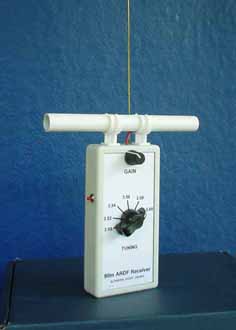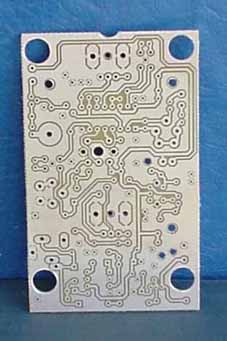To promote IARU style ARDF in the UK, there was a need for a 'home grown' receiver to be made available. At the same time no one wanted to reinvent the wheel and there are many designs to be found on the internet.
Experience had shown that some attributes were important

The Design
One of the major problems facing designers of RF equipment for the home builder is the disappearance of many of the ICs we once took for granted. There are a number of designs that have fallen foul of this phenomenon.
This receiver makes use of the tried and tested TCA440 which is still being manufactured in China. A design was found on the internet by PA0HRX using a TCA440 and an LM386 audio chip and this receiver is based on this design. Virtually every 80m ARDF transmitter uses a NTSC colour burst crystal on 3580kHz. Hence, there is no need to have variable front end tuning and the ferrite rod is simply peaked up on this frequency.
The sensitivity is perfectly adequate for 80m ARDF and in fact is better than a German designed receiver using a TCA440 in a direct conversion arrangement. The receiver presented here is a conventional superhet with cascaded 4kHz wide ceramic filters in the IF.
On/off switching is achieved by plugging in the headphones and a FET switch arrangement allows the use of stereo phones whereas some of the continental designs use mono phones plugged into a stereo socket to achieve this. Mono phones are getting hard to find and are expensive compared to the stereo ones when you do find them.
What you get How to order 'Health warning!'
The picture of the receiver to the left shows the simplicity of the resulting design. There are just two variable controls, tuning and gain; and a 'sense' button on the side. Dave G6UWO has designed a superb PCB for the project and this is pictured left. The variable controls are mounted directly onto the PCB, the sense antenna plugs directly into the PCB and only four pairs of wires have to be soldered to the PCB.
Dave G6UWO has designed a superb PCB for the project and this is pictured left. The variable controls are mounted directly onto the PCB, the sense antenna plugs directly into the PCB and only four pairs of wires have to be soldered to the PCB.
The kit includes a pre-drilled case, pcb, all components, a pre-manufactured sense antenna and a full set of instructions. Not included is the PP3 battery and a pair of stereo 3.5mm headphones.
The kit costs £40 plus £3 postage and packing, making £43 in total.
The latest version features a new high quality PCB with full silk screening and plated through holes.
To order send a cheque for the appropriate amount and your return address to Bob Titterington G3ORY, Wiclif House, St Mary's Road, Lutterworth, Leicester, LE17 4PS.
These kits are produced on a 'not-for-profit' basis in order to promote IARU style ARDF in the UK. The kits are sold as a private initiative and are not marketed or warranted by the RSGB.